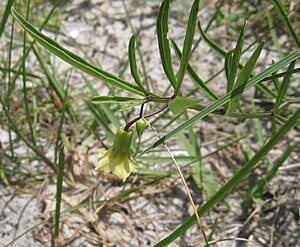Physalis angustifolia
| Physalis angustifolia | ||||||||||||
|---|---|---|---|---|---|---|---|---|---|---|---|---|

Physalis angustifolia |
||||||||||||
| Systematics | ||||||||||||
|
||||||||||||
| Scientific name | ||||||||||||
| Physalis angustifolia | ||||||||||||
| Nutt. |
Physalis angustifolia is a plant type from the genus of jujubes ( Physalis ) in the family of the nightshade family (Solanaceae).
description
Vegetative characteristics
Physalis angustifolia is a perennial plant with a deep underground rhizome that is often slender and flat. The stems reach heights of 15 to 60 cm and are erect or spread along the ground and are ascending. The stems and leaves are mostly hairless, only rarely are the leaf margins covered with short, branched trichomes that are 1 mm long or shorter.
The leaves are sessile, narrow spatulate to linear-lanceolate, they are 3 to 10 (rarely up to 12) cm long and 0.2 to 1.5 (rarely up to 2) cm wide. The tip is blunt to pointed, the leaf margin is entire and the leaf base tapers towards the stem axis.
blossoms
The flowers are on 11 to 24 (rarely up to 32) mm long pedicels . The calyx has a length of 5 to 9 (rarely up to 10) mm and is covered with (rarely only 1) 1.5 to 3.5 mm long lobes. Except for the edges, it is hairless or occasionally covered with short, branched trichomes that are 1 mm long or shorter. The crown has a length of 11 to 15 (rarely 8 to 16) mm and is marked in the throat with ocher-colored to green, inconspicuous spots. The main vein of the petals is typically purple or red in color. The anthers have a length of 2.5 to 3.5 mm and are twice as wide as the stamens .
fruit
The fruits are orange colored berries . The stalk extends on the fruit to 15 to 25 (rarely up to 42) mm. The calyx becomes 2 to 3 (rarely 1.5 to 4) cm long and measures 1.5 to 2.5 mm in diameter. When the fruit ripens, it is usually orange in color.
Occurrence and locations
The species is distributed in southern Alabama , Louisiana and Mississippi, as well as along the Florida part of the coast of the Gulf of Mexico . It grows on the dunes of the Gulf and on disturbed soils in the sand. On the Florida peninsula, the species hybridizes with Physalis walteri , so that populations with characteristics of both species can be found there.
proof
- Janet R. Sullivan: Systematics of the Physalis viscosa Complex (Solanaceae) . In: Systematic Botany , Volume 10, Number 4, 1985. pp. 426-444.